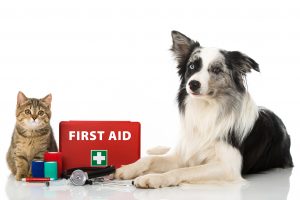You likely know what to do if you experience a minor injury, but do you know how to help your pet if she gets hurt? Our first aid guide will prepare you to care for your furry friend until she can be evaluated by our veterinary team.
Every pet owner should have a fully stocked first aid kit available at a moment’s notice. Keep supplies in a small, sturdy container, like a toolbox, and ensure every household member knows where it is kept. Your kit should contain:
Inventory your first aid kit monthly. Replenish used materials and replace expired products.

If your pet is actively bleeding, carefully apply firm, steady pressure to the wound with gauze pads for several minutes. Be cautious, because pets who are feeling pain may be more likely to bite. After bleeding has stopped, remove the gauze and examine the wound. You can rinse the area with sterile saline, but don’t wipe the blood away, because you will remove the clot that has formed. If the wound is small and superficial, dry it and apply antibiotic ointment.
If the wound is deep, large, or has gaping edges, rinse it quickly, if possible, bandage it and seek help from your veterinarian immediately. If stitches are needed, they must be placed within hours, because wound edges will not adhere to each other once they begin healing.
If your pet is burned and the burn appears to be minor, run the affected area under cool running water for 20 minutes. If you don’t have access to cool water, apply a cool compress to the area. Do not apply ointments, as this can lead to infection. Seek veterinary care immediately, as many burns require prescription medications to heal without becoming infected.
Pets often try to eat insects, so check your pet’s face and mouth for a small bump or a stinger if you think she’s been bitten. To remove a stinger, scrape a hard, plastic object like a credit card over her skin. Don’t try to remove it with tweezers or your fingers, because you can squeeze more poison into your pet.
Dogs and cats can be allergic to bug bites. After removing a stinger, monitor your pet closely for signs of an allergic reaction, which can include:
If you notice signs of an allergic reaction, take your pet to the nearest veterinary hospital immediately.
Toenails often catch on something or are trimmed too short accidentally. If the quick (the blood vessels and nerves in the nail’s center) is exposed, the nail will bleed and be painful. If your pet has torn her toenail, wrap her foot in gauze and see your veterinarian, because a local anesthetic or sedation may be needed to safely remove the dangling nail and treat the exposed nerve. For a nail trimmed too short, pack styptic powder into the exposed tip or apply a styptic pencil to stop the bleeding.
Animals are notorious for eating toxic products. According to the American Society for the Prevention of Cruelty to Animals (ASPCA) Animal Poison Control Center, the toxins most commonly ingested in 2018 were:
If your pet has ingested a potential toxin, call ASPCA Animal Poison Control Center at 888-426-4435, or call the RBVH location closest to you to see if it’s safe to induce vomiting. To make your pet vomit, load a syringe or turkey baster with 3% hydrogen peroxide at a dose of one teaspoon per 12.5 pounds (0.4 milliliters per pound) and slowly inject it into her mouth. Immediately after vomiting, bring your pet to our hospital for follow-up care to ensure all of the toxin was eliminated.
If you have questions about administering first aid to your pet, call the RBVH closest to you.